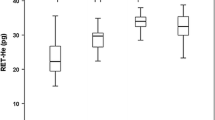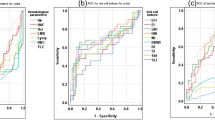Abstract
The aim of the study was to evaluate the role of hypochromic erythrocytes (HYPO%) compared to “traditional” and novel markers of iron status and erythropoiesis in recognizing iron-restricted erythropoiesis (IRE) and predicting response to erythropoietin (rHuEPO) in anemic patients with myeloma and lymphoma. Forty-one newly diagnosed patients who received epoetin-beta at a subcutaneous weekly dose of 30,000 IU for 6 weeks were studied. Response to rHuEPO was observed in 27 patients (65.8%). Twelve non-responders received, additionally, 200 mg of IV iron sucrose, weekly, for 4 weeks. Evaluation of markers was performed at baseline and on weeks 1, 2 and 6 for all patients and also on weeks 7–10 for non-responders to rHuEPO. Baseline HYPO%, at a cut-off value of <5%, and an increment in reticulocyte absolute number (RETICS-AB) ≥ 50,000/μl and reticulocyte hematocrit (RETICS-Hct) ≥ 50%, between baseline and week 2, were independent predictive factors for response to rHuEPO. We found that these markers had superior predictive value for response to rHuEPO than four widely used predictive models. Furthermore, a baseline HYPO% count of above 5% proved superior over serum ferritin < 100 ng/ml and transferrin saturation < 20% in recognizing IRE. In conclusion, baseline HYPO% either alone or in combination with RETICS-AB or RETICS-Hct after 2 weeks of rHuEPO treatment could be reliably used in predicting response to rHuEPO. Additionally, HYPO% has proved a reliable marker for recognizing IRE before rHuEPO treatment and, thus, could be used for identifying patients who will benefit from IV iron supplementation.


Similar content being viewed by others
References
Alexanian R, Dimopoulos M (1994) Treatment of multiple myeloma. N Engl J Med 330:484–489
Arndt U, Kaltwasser JP, Gottschalk R, Hoelzer D, Moller B (2005) Correction of iron-deficient erythropoiesis in the treatment of anemia of chronic disease with recombinant human erythropoietin. Ann Hematol 84:159–166
Auerbach M, Ballard H, Trout JR, McIlwain M, Ackerman A, Bahrain H, Balan S, Barker L, Rana J (2004) Intravenous iron optimizes the response to recombinant human erythropoietin in cancer patients with chemotherapy-related anemia: a multicenter, open-label, randomized trial. J Clin Oncol 22:1301–1307
Beguin Y (1995) Erythropoiesis and erythropoietin in multiple myeloma. Leuk Lymphoma 18:413–421
Beguin Y (2005) Intravenous iron and recombinant human erythropoietin in cancer patients. J Clin Oncol 23:651–652
Bokemeyer C, Aapro MS, Courdi A, Foubert J, Link H, Osterborg A, Repetto L, Soubeyran P (2004) EORTC guidelines for the use of erythropoietic proteins in anaemic patients with cancer. Eur J Cancer 40:2201–2216
Bovy C, Gothot A, Krzesinski JM, Y Beguin (2005) Mature erythrocyte indices: new markers of iron availability. Haematologica 90:549–551
Braun J, Lindner K, Schreiber M, Heidler RA, Horl WH (1997) Percentage of hypochromic red blood cells as predictor of erythropoietic and iron response after i.v. iron supplementation in maintenance haemodialysis patients. Nephrol Dial Transplant 12:1173–1181
Cavill I (2002) Erythropoiesis and iron. Best Pract Res Clin Haematol 15:399–409
Cazzola M, Ponchio L, Pedrotti C, Farina G, Cerani P, Lucotti C, Novella A, Rovati A, Bergamaschi G, Beguin Y (1996) Prediction of response to recombinant human erythropoietin (rHuEpo) in anemia of malignancy. Haematologica 81:434–441
Cazzola M, Beguin Y, Kloczko J, Spicka I, Coiffier B (2003) Once-weekly epoetin beta is highly effective in treating anaemic patients with lymphoproliferative malignancy and defective endogenous erythropoietin production. Br J Haematol 122:386–393
Coiffier B (2000) The impact and management of anaemia in haematological malignancies. Med Oncol 17(Suppl 1):S2–S10
Cucuianu A, Patiu M, Rusu A (2006) Hepcidin and multiple myeloma related anemia. Med Hypotheses 66:352–354
Fishbane S, Galgano C, Langley RC Jr, Canfield W, Maesaka JK (1997) Reticulocyte hemoglobin content in the evaluation of iron status of hemodialysis patients. Kidney Int 52:217–222
Glaspy J, Cavill I (1999) Role of iron in optimizing responses of anemic cancer patients to erythropoietin. Oncology 13:461–473
Henry D, Abels R, Larholt K (1995) Prediction of response to recombinant human erythropoietin (r-HuEPO/Epoietin-alpha) therapy in cancer patients. Blood 85:1676–1678
Katodritou E, Speletas M, Zervas K, Kapetanos D, Georgiou E, Christoforidou A, Pavlitou A, Sion M, Christakis J (2006) Evaluation of hypochromic erythrocytes in combination with sTfR-F index for predicting response to r-HuEPO in anemic patients with multiple myeloma. Lab Hematol 12:47–54
Kyle RA (1975) Multiple myeloma: review of 869 cases. Mayo Clin Proc 50:29–40
Littlewood TJ, Zagari M, Pallister C, Perkins A (2003) Baseline and early treatment factors are not clinically useful for predicting individual response to erythropoietin in anemic cancer patients. Oncologist 8:99–107
Ludwig H, Fritz E, Leitgeb C, Pecherstorfer M, Samonigg H, Schuster J (1994) Prediction of response to erythropoietin treatment in chronic anemia of cancer. Blood 84:1056–1063
Macdougall IC (1998) What is the most appropriate strategy to monitor functional iron deficiency in the dialysed patient on rhEPO therapy? Merits of percentage hypochromic red cells as a marker of functional iron deficiency. Nephrol Dial Transplant 13:847–849
Means RT Jr, Krantz SB (1992) Progress in understanding the pathogenesis of anemia of chronic disease. Blood 80:1639–1647
Mittelman M (2003) Implications of anemia in multiple myeloma. Clin Lymphoma 4:23–29
Osterborg A, Boogaerts MA, Cimino R, Essers U, Holowiecki J, Juliusson G, Jager G, Najman A, Peest D (1996) Recombinant human erythropoietin in transfusion-dependent anemic patients with multiple myeloma and non-Hodgkin’s lymphoma—a randomized multicenter study. The European Study Group of Erythropoietin (Epoetin Beta) Treatment in Multiple Myeloma and Non-Hodgkin’s Lymphoma. Blood 87:2675–2682
Pangalis GA, Angelopoulou MK, Vassilakopoulos TP, Siakantaris MP, Kittas C (1999) B-chronic lymphocytic leukemia, small lymphocytic lymphoma and lymphoplasmacytic lymphoma, including Waldestrom’s macroglobulinemia: A clinical, morphologic and biologic spectrum of similar disorders. Semin Hematol 36:104–114
Rizzo JD, Seidenfeld J, Piper M, Aronson N, Lichtin A, Littlewood TJ (2001) Erythropoietin: a paradigm for the development of practice guidelines. Hematology (Am Soc Hematol Educ Program) 1:10–30
Stasi R, Amadori S, Littlewood TJ, Terzoli E, Newland AC, Provan D (2005) Management of cancer-related anemia with erythropoietic agents: doubts, certainties, and concerns. Oncologist 10:539–554
Tessitore N, Solero GP, Lippi G, Bassi A, Faccini GB, Bedogna V, Gammaro L, Brocco G, Restivo G, Bernich P, Lupo A, Maschio G (2001) The role of iron status markers in predicting response to intravenous iron in haemodialysis patients on maintenance erythropoietin. Nephrol Dial Transplant 16:1416-1423
Thomas C, Thomas L (2002) Biochemical markers and hematologic indices in the diagnosis of functional iron deficiency. Clin Chem 48:1066–1076
Thomas C, Thomas L (2005) Anemia of chronic disease: pathophysiology and laboratory diagnosis. Lab Hematol 11:14–23
Weiss G, Goodnough LT (2005) Anemia of chronic disease. N Engl J Med 352:1011–1023
Acknowledgments
This study is complied with the current Greek law and was supported in part by the Municipality of Thessaloniki and “Papageorgiou” General Hospital, Thessaloniki, Greece. We would like to thank Mrs. Chrisavgi Mirahtsi and Mrs. Maria Varsami for their excellent technical assistance and Mr. George Christopoulos, Director of “Papageorgiou” General Hospital, for his support in the study.
Author information
Authors and Affiliations
Corresponding author
Rights and permissions
About this article
Cite this article
Katodritou, E., Terpos, E., Zervas, K. et al. Hypochromic erythrocytes (%): a reliable marker for recognizing iron-restricted erythropoiesis and predicting response to erythropoietin in anemic patients with myeloma and lymphoma. Ann Hematol 86, 369–376 (2007). https://doi.org/10.1007/s00277-007-0258-x
Received:
Accepted:
Published:
Issue Date:
DOI: https://doi.org/10.1007/s00277-007-0258-x




